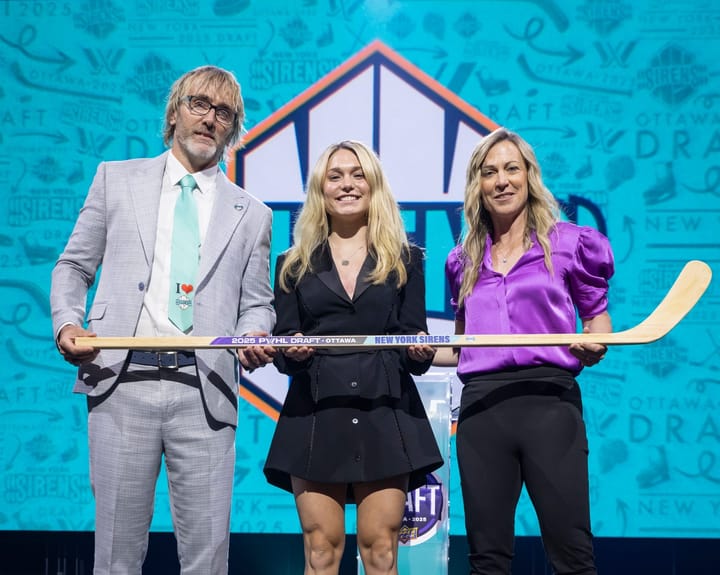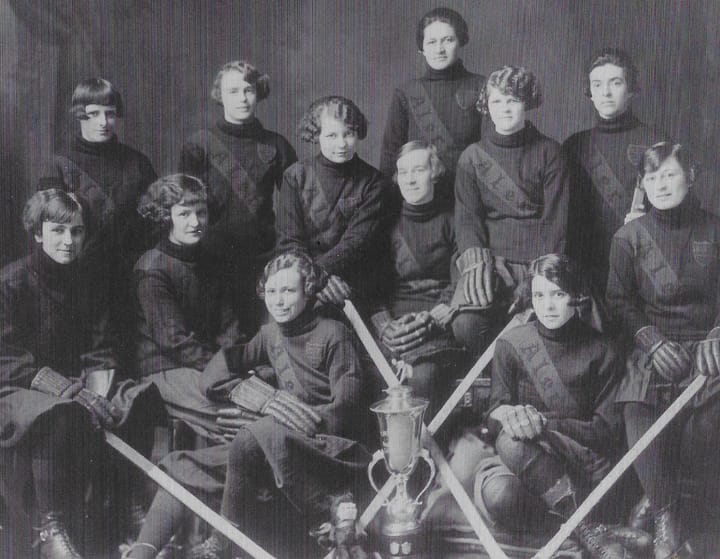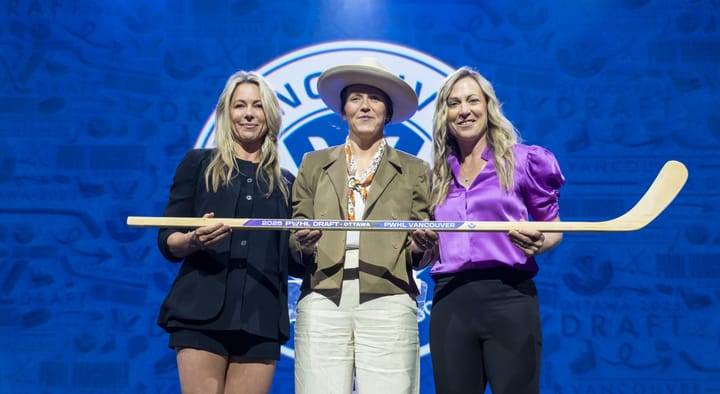CWHL to NWHL: They’re (probably) not shipping down to Boston
Canadian players to U.S. teams? It’s less likely than you think.
Note: The author of this piece is an immigration lawyer, but this piece should not be taken as legal advice. If you have immigration questions, contact an immigration attorney in your area. If you are an active player, contact your team’s General Manager or General Counsel.
With the news that the Canadian Women’s Hockey League is folding as of April 1, many players are faced with the option of moving to the United States to follow their hockey dreams. Although the NWHL has opted to add two teams in Montréal and Toronto, the decision still leaves many players who may be on the roster bubble wondering if they might be able to make the move to another U.S. team.
Aside from practical considerations, every individual who is not a U.S. citizen or Legal Permanent Resident (the formal term for green card holder) needs to have two kinds of legal authorization from the U.S. government: 1) authorization to be present in the U.S.; and 2) authorization to work in the U.S.
P1 and O1 visas for athletes
The way that most men’s professional athletes, including NHL players, accomplish those two goals is through the P1A Athlete visa or the O1A Extraordinary Ability visa. Most P and O visas are run through the leagues themselves so that in the case of a trade, the new team only has to file an amendment to the visa, rather than an entirely new one. Canadian citizens playing in Canada traded to U.S. teams need an entirely new visa, which may take significant work to obtain on such a short notice even for major sports leagues.
P and O visas takes some effort to obtain, and there’s no guarantee that any player signed by the NWHL would immediately be eligible. National team players would almost definitely qualify for P visas, and potentially an O visa. Canadian non-national players in the past have had P1A visas— including Kaleigh Fratkin— but there’s no guarantee that means everyone can get a P1A, and non-national team members are likely not at a high enough level to prove that they are eligible for the O visa. There are also individual requirements regarding recognition, particularly collegiate or international recognition, media attention, and awards in the field. It’s likely a player who doesn’t yet qualify for either an O or P could come on a B1 Visitor for Business visa and work towards building the resume they might need to obtain a P visa. Individual players might qualify for an H-2B visa as a seasonal, non-agricultural worker, but that visa is not guaranteed as only 66,000 visas are issued each year (33,000 per half-year). This year, employers were so desperate to file for H-2Bs that they crashed the Department of Labor’s servers for several days after the New Year’s Day filing deadline.
The problem, of course, is that the P and O visa, as well as all non-immigrant “letter” visas, only allow you to work for your sponsoring employer (in this case, the NWHL). You cannot be a professional athlete on a P1A visa and have a “day job”. This is meant to protect player compensation and ensure that foreign nationals coming on P and O visas are truly professional athletes. And although the NWHL is looking to increase salaries this year, it’s likely not enough to live on. This means players are going to need outside work.
P visa holders are allowed to earn income incident to their employment as a professional athlete. What this means is that Jeff Skinner and Rasmus Dahlin could host a Ouellette/Poulin style hockey camp where they charge youth players attendance fees, and keep the money even though it didn’t come from their employer (the Buffalo Sabres). Why? Because it’s directly related to their employment with the NHL as professional hockey players.
In the women’s game, this usually goes the other way around: the incident employment is usually the player’s main employment. Some foreign players are able to get full-time jobs with hockey powerhouses as coaches. Others, particularly earlier in the league when salaries were higher, scraped by on private lessons and day-to-day hockey-related work.
Bringing Others
P and O visas also allow the principal visa holder (i.e. the P1A or O1A athlete) to bring their staff with them so that they can perform at the professional level. Usually this is more applicable to athletes who perform as individuals, but it can apply to team sport athletes as well. O1A athletes can bring their essential staff with them on O2 visas; P1A athletes can bring their staff with them on P1S visas.
Other Visas
It’s possible, and very likely, that players want a full-time, fulfilling job rather than trying to put together rent and gas money from various hockey opportunities. With teams along the high-cost eastern seaboard, this is probably the better plan.
With most, if not all, players having spent four years in college to earn a degree, the most obvious visa to hold would be an H-1B visa. However, this visa is only available to individuals whose jobs themselves require a bachelor’s degree (“specialty occupations”). Just because a bachelor’s degree holder does the job doesn’t mean the job requires a bachelor’s degree, and therein lies the problem. For example: Many registered nurses have bachelor’s (BSN) degrees. However, it is possible to be a registered nurse in the U.S. with only a two-year degree. Thus, nurses are not eligible for this kind of visa.
Most immigration practitioners will also be quick to tell you that the government has been aggressively challenging whether or not many H-1B jobs actually require a four-year degree. On top of all that, the H-1B visa is not guaranteed, and nearly all requests for the visa must be filed between... April 1 and April 5, 2019. It’s too late for that kind of visa to be an option for players looking to move, after only having learned of the league’s demise on Sunday March 31.
Many players first play four years at an NCAA institution and then turn professional. Each student who attends a U.S. institution is eligible for one full year of work authorization under the F1 Optional Practical Training Program. Depending on her field of study, the player may be eligible for an additional two years’ extension. The work must be related to the field of study, however— the student cannot use their OPT to play for the NWHL, even if she played on her programs top line for all four years.
As many players who are looking to move are Canadian, another option might be the Trade NAFTA (TN) visa, available only to Canadian (and Mexican) citizens. This visa is extremely attractive to employers due to its cost, easy application, and infinite (well, as long as NAFTA or its successor agreement lasts) renewability.
The problem is that it is only available for certain professions, so whether or not each player looking to move is eligible depends on their jobs. In addition, a lot of the professions listed require licensure in the U.S.— meaning players may need to take U.S. licensing exams, or, at the very least, know which state they will be moving to.
Family Issues
Family is one of the key reasons why players may choose to move or stay in their current location. Unfortunately for players, both major options allow spouses to accompany the principal visa holder, but do not allow them to work.
O1A and P1A athletes can bring their spouses and children under the age of 21 as O3 and P4 dependents respectively, but the O3/P4 spouse cannot work— they must qualify for their own independent work visa. This is likely one of the reasons that many male athletes’ spouses form daytime social clubs— they literally cannot do anything else.
TN holders are in a similar situation— they can bring their spouses and children under 21 on TD (Trade Dependent) visas. Like O3 and P4 holders, they too cannot work unless they independently qualify for their own work visas. Of course, there is a way to solve this problem.
Green Cards
Going from work visa to green card is rather common. Although it is possible to get an immigrant visa to come directly to the U.S. without first being on another visa, it is fairly rare.
For most occupations, the U.S. employer must prove that there is no qualified, willing, or available worker in the area that can take the job. The two exceptions are nurses (including nurse practitioners) and physical therapists. The process of proving that the foreign worker is the only person to do the job usually takes around a year— and the process of actually getting the green card once you’ve been cleared can take another year or two after that. O1A athletes, however, can completely skip this process— they can immediately file for a green card.
Players born in Canada, Finland, Sweden, and Japan currently face no line for a green card, but the same cannot be said of players born in China, who face a years-long wait. In the past, however, there has often been a wait time regardless of the person’s country of birth. The current short line is not guaranteed to last, which may prolong the amount of time where a player has to choose between being paid to do her day job and being paid to play hockey.
The good news is that if a player is applying for a green card, her spouse and children under the age of 21 can be included in her application, so the whole family can stay together in the U.S. (and all be able to work, go to school, and travel.)
The long and short of it all is that moving to the U.S. isn’t easy. Our visa system is already fairly restrictive, and our athlete visas were created in 1990, with men’s traditional revenue sports in mind. Unless the NWHL is able to provide livable salaries, or the visa system dramatically opens up, don’t expect to see huge numbers of Canadian players jumping towards the American-based teams.





Comments ()